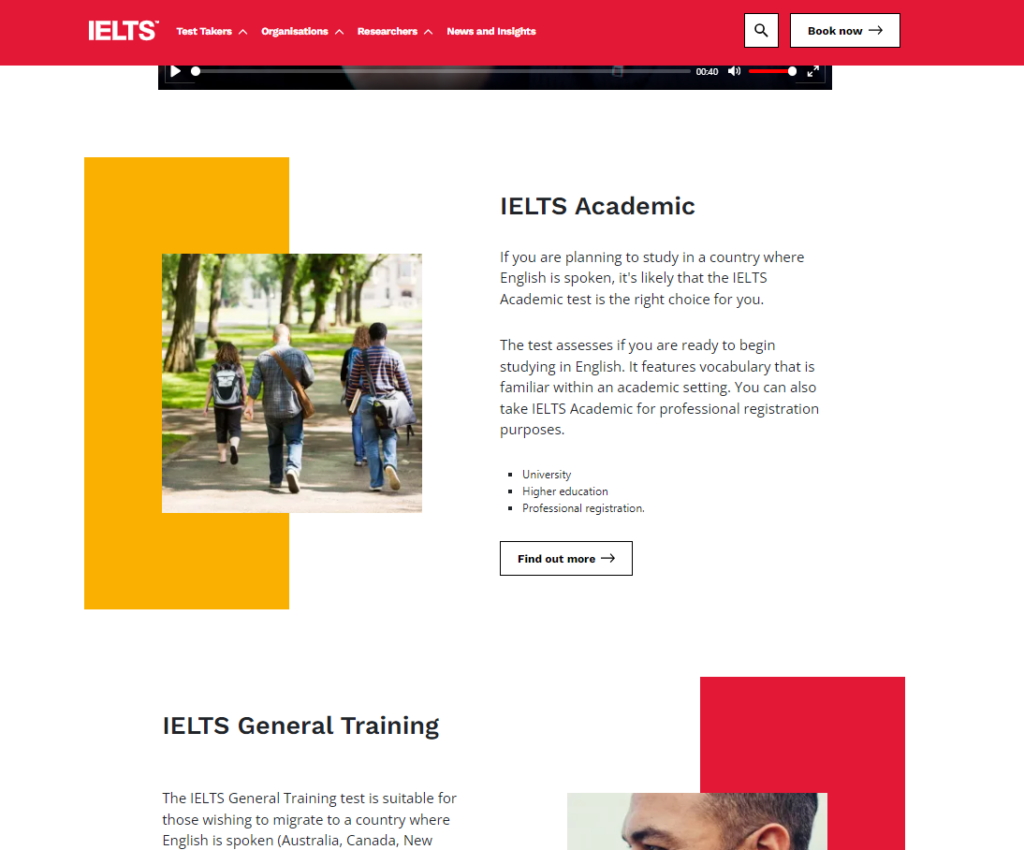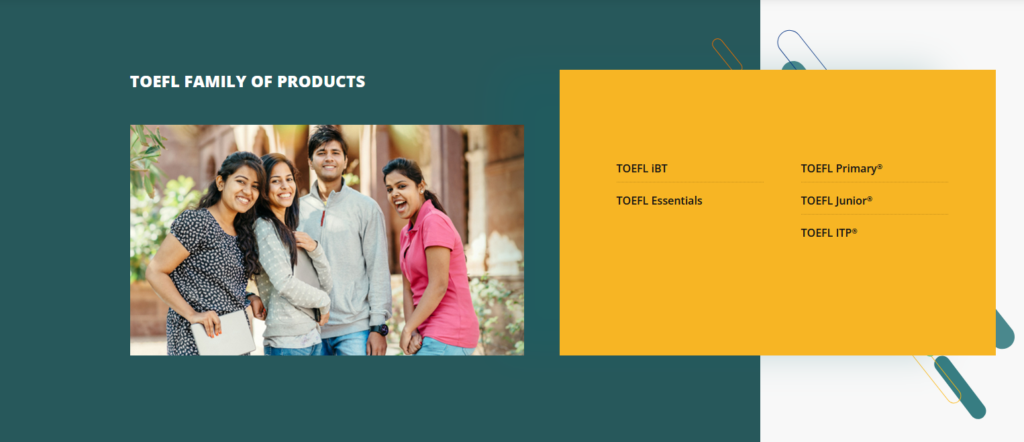Summary
- TOEFL is predominantly recognised and required in the USA, and also accepted for immigration in Australia and New Zealand.
- Predominantly recognized in the USA, and accepted for immigration in Australia and New Zealand.
- Would you like to build a future in an English-speaking country.
Do you dream of studying abroad? Would you like to build a future in an English-speaking country?
If so, demonstrating your English language skills is a crucial step. It is not enough to be good at math and exceptional in physics. Those capabilities are laudable but you have to be able to converse fluently with your professors and cohorts.
In this article, we will introduce you to TOEFL and IELTS—the two most widely recognized English proficiency tests. But which test should you take? Do universities prefer one over the other and which is easier, TOEFL or IELTS? We shall also shed light on the differences between TOEFL and IELTS.
Also Read: Top Exams For Studying Abroad [Comprehensive Guide]
Differences between the IELTS and TOEFL exams
Before we share the table, let’s start with a very brief description.
IELTS (International English Language Testing System)
IELTS is administered by the British Council, IDP, and Cambridge English. It commenced in 1989.
IELTS is used for academic, professional, and immigration purposes globally. IELTS is also crucial for study-abroad applicants, professionals, and immigrants to English-speaking countries. The IELTS site offers comprehensive information about the exam and its scope.

TOEFL (Test of English as a Foreign Language)
TOEFL is administered by the Educational Testing Service or ETS. It is much older and has been around since 1965.
TOEFL is more focused on academic purposes. TOEFL is predominantly recognised and required in the USA, and also accepted for immigration in Australia and New Zealand.
TOEFL is run by an organisation named ETS. The website offers all the details about the test format and time allowed.

Choosing between TOEFL and IELTS depends on your specific needs. Both tests are globally recognized. Yet they test different aspects of English language proficiency.
This table provides a comparative overview of the TOEFL and IELTS tests across various aspects.
| Category | IELTS | TOEFL |
| Scope and Application | Used for academic, professional, and immigration globally. Crucial for study-abroad, professionals, and immigrants. | More focused on academic purposes. Predominantly recognized in the USA, and accepted for immigration in Australia and New Zealand. |
| Test Variations | Two versions: Academic for higher education and General Training for work and immigration. | Primarily for academic purposes, accepted by universities in various countries. |
| Global Availability | Available in over 140 countries with many testing locations. | Accessible in more than 170 countries; offers a home edition for added flexibility. |
| Popularity and Test-Taker Volume | Over 3.5 million candidates annually. | Attracts over 2.3 million aspirants each year, especially in the USA and Canada. |
| Interaction with Examiner | Direct interaction with an examiner during the speaking section. | Speaking responses recorded without direct examiner interaction. |
| Scoring System | Utilizes a band system, scoring from 1 to 9 for each section and overall. | Scored out of 120 points, each section graded from 0 to 30. |
| Exam Duration | 2 hours and 45 minutes. | Approximately 1 hour and 56 minutes for the internet-based test. |
| Frequency of Tests | Weekly testing, 48 test dates available per year. | Over 60 sessions per year globally, available five days a week in many cities. |
| Result Declaration | Online results in 3-5 days for computer tests; paper-based results in up to 13 days. | Scores typically available within 4-6 days from the test date. |
| Purpose and Audience | Suitable for academic, professional, and immigration purposes. | Primarily for academic and professional purposes, including university admissions and employment. |
| Test Format | Comprises Listening, Reading, Writing, and Speaking sections, with in-person Listening and Speaking. | Entirely computer-based with Reading, Listening, Speaking, and Writing sections. |
| Accent and Vocabulary | Incorporates various accents and a broad range of vocabulary. | Focuses on North American accents and academic vocabulary. |
| Speaking Section | Involves a face-to-face interview. | Responses recorded to prompts, without face-to-face interaction. |
| Reading and Writing Sections | Features varied question types and texts from different sources. | Comprises academic passages with multiple-choice questions. |
| Validity Period | Scores valid for 2 years. | Scores valid for 2 years. |
| Migration Considerations | Accepted for migration in countries like Canada, the UK, Australia, and New Zealand. | Not recognized for migration to Canada and the UK; accepted in Australia (TOEFL iBT only). |
| Test Flexibility | Offers both computer-delivered and paper-based testing options. | Primarily administered on computers. |
| Scoring Clarity | Employs a straightforward scoring system. | Uses a more complex “raw” and “scaled” score system. |

Also Read: TOEFL Exam Pattern in 2024: Latest & Updated
IELTS versus TOEFL: Examination structure and curriculum
While the table above sheds some light on the differences between IELTS and TOEFL, it’s time to deep dive into each of these test formats. When comparing the IELTS and TOEFL exams in terms of pattern and syllabus, there are several key differences:
Reading Section
1. TOEFL: This section involves reading 3-4 university-level educational texts. Each is followed by about 10 questions which focus on comprehension skills.
2. IELTS: In this section, test-takers are provided three passages. These serve as the basis for a variety of comprehension questions.
TOEFL allocates 54-72 minutes for the reading section. IELTS provides 60 minutes.
Listening Section
1. TOEFL: The section includes 3-4 lectures and 2-3 conversations. Each is followed by a series of questions and takes 41-57 minutes to complete.
2. IELTS: It consists of four recorded monologues or conversations, with a total duration of 30 minutes.
Writing Section
1. TOEFL: Includes two tasks, the first one combines reading, listening, and writing. Plus an independent essay writing task, to be completed in 50 minutes.
2. IELTS: Features two tasks – a concise essay and a more extensive essay. They have a total duration of 60 minutes.
Speaking Section
1. TOEFL: Comprises four tasks, evaluated by an examiner, and takes about 17 minutes.
2. IELTS: Involves a face-to-face interview with an examiner, lasting 11-14 minutes.
Also Read: IELTS Exam Dates 2025 in India: All Important Timelines
TOEFL vs IELTS – Which is easier?
There isn’t a clear-cut answer to this question. It is wrong to assume that one is lesser or easier. Much of it depends on your strengths and weaknesses as a test taker, as well as the format you prefer.
Here are some factors to help you decide:
Reading & Listening
1. TOEFL reading passages tend to be more academic and can involve technical vocabulary.
2. IELTS reading sections draw from various sources like newspapers and magazines, offering a wider range of topics.
However, both have similar listening sections.
Speaking & Writing
1. IELTS speaking involves a face-to-face interaction with an examiner. This might make some test takers nervous.
2. TOEFL speaking is computer-based, where you speak into a microphone.
Writing requirements differ slightly since TOEFL essays are a bit longer.
Test Format
1. TOEFL is primarily computer-based.
2. IELTS offers both computer-based and paper-based options.
Some test-takers find the computer format of TOEFL more comfortable. However, many prefer the traditional pen-and-paper approach of IELTS.
Ultimately, the “easier” test boils down to your preferences.
TOEFL vs IELTS – Which should I take?
As a student from India considering studying abroad, you have to weigh many factors, and choosing between IELTS and TOEFL is not easy.
- IELTS: This test is widely accepted in the UK, Australia, and Canada. IELTS is also recognized by many universities in the USA. The academic version is suitable for university applications.
- TOEFL: Predominantly favored in the USA and also accepted in Canada, Australia, and the UK. It’s more focused on academic English and is mostly computer-based.
Also Read: TOEFL Exam Pattern in 2025: Latest & Updated
How to apply for IELTS and TOEFL?
Here are the steps to apply:
Applying for IELTS
- Visit the official IELTS website.
- Choose between Academic or General Training.
- Select a test center and a suitable date.
- Utilize free preparation materials available on the website.
Applying for TOEFL
- Register through the ETS website using an ETS account.
- Choose a test date and center.
- Access TOEFL preparation materials and resources online.
- Follow online instructions for a step-by-step registration process.
FAQs: TOEFL vs IELTS
1. How often can I retake the TOEFL or IELTS exam?
You are allowed unlimited attempts at both the IELTS and TOEFL exams. If you are not satisfied with your initial score, you can retake the test on the next available date.
2. Is there a required waiting period between TOEFL or IELTS attempts?
There is a 12-day waiting period for retaking TOEFL. There is no such waiting period before you retake IELTS.
3. Where can I find official, free IELTS preparation resources?
The official IELTS website provides a range of free resources, including sample tests and preparation tips. Additionally, various online educational platforms offer free practice materials.
4. What free study materials are available for TOEFL preparation?
The official TOEFL website offers several free resources, such as sample questions and answers. Besides these, some other educational websites also provide free TOEFL practice tests and study guides.
5. Can taking TOEFL or IELTS multiple times improve my score?
Repeatedly taking the IELTS or TOEFL tests can potentially improve your score. Familiarity with the test format and question types often increases with experience. We recommend you analyze previous test performance to identify areas for improvement and then prepare accordingly.




















































































































































